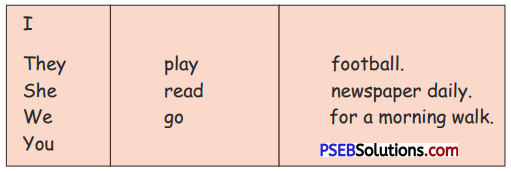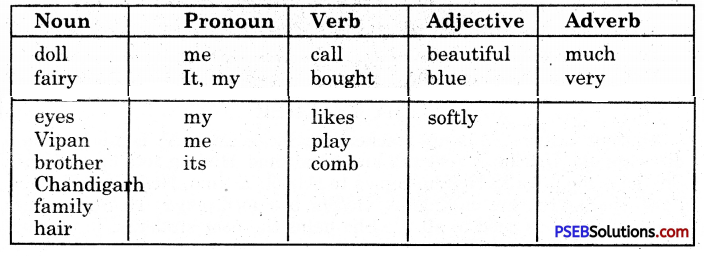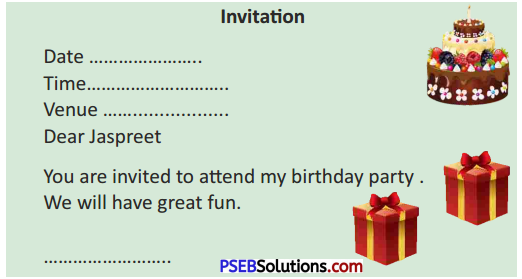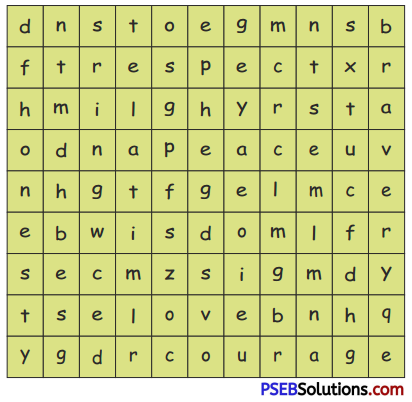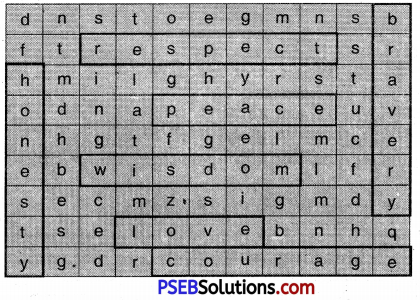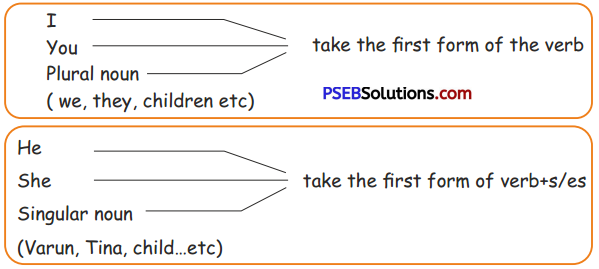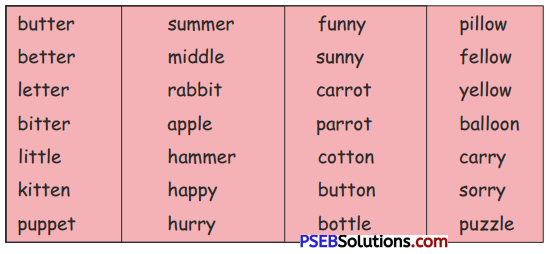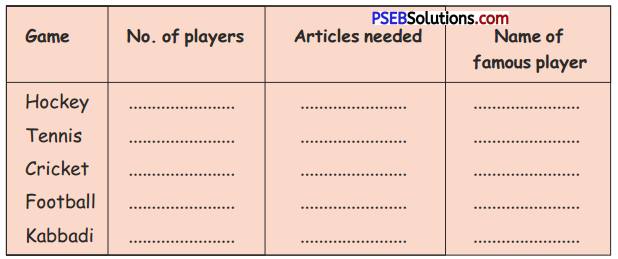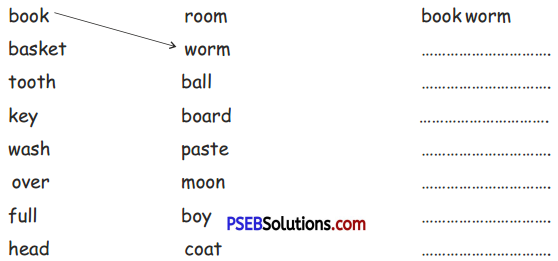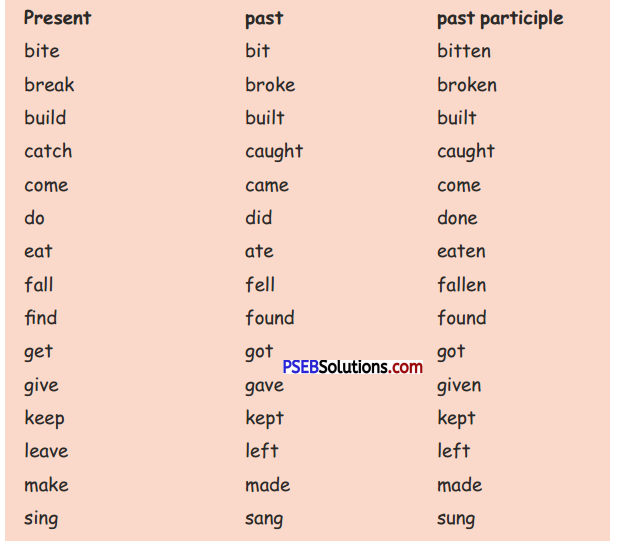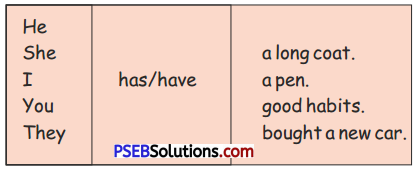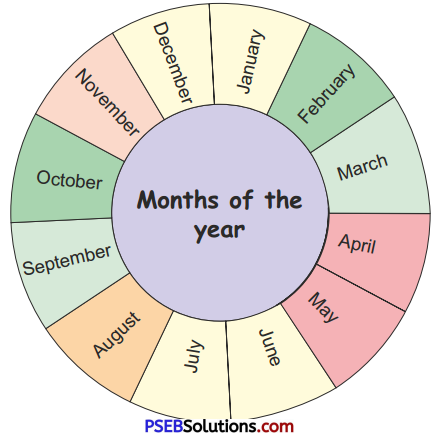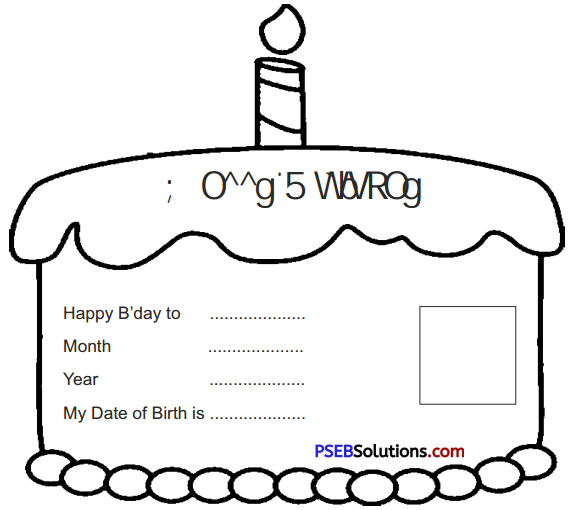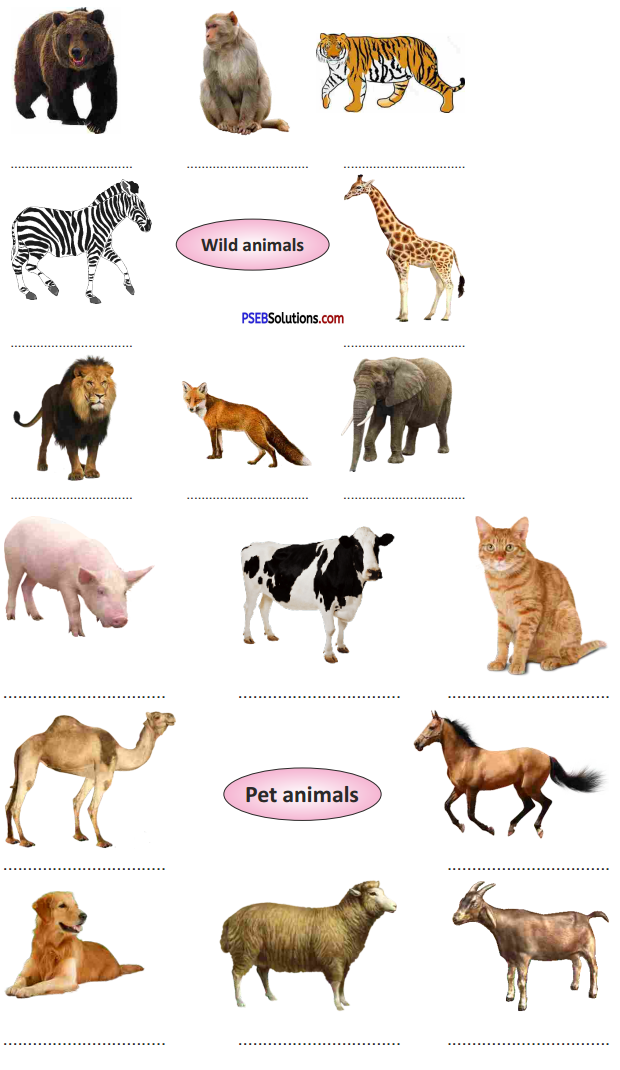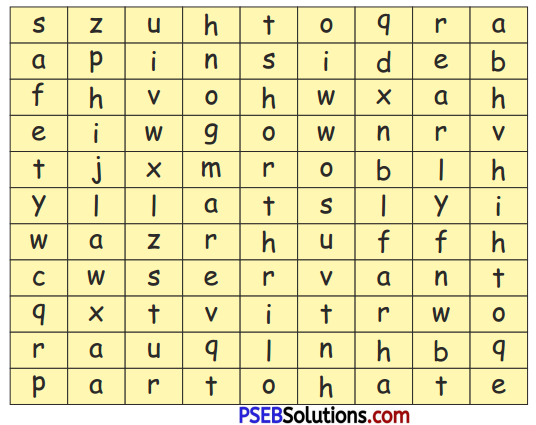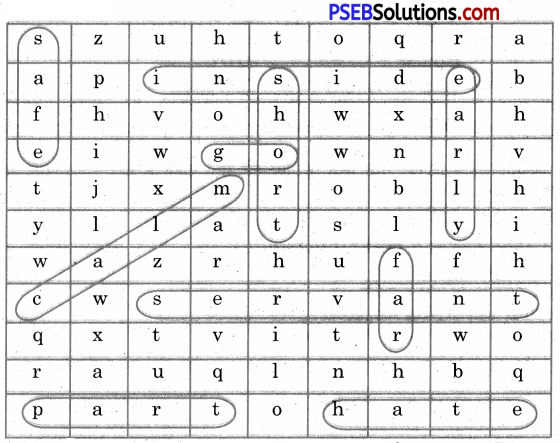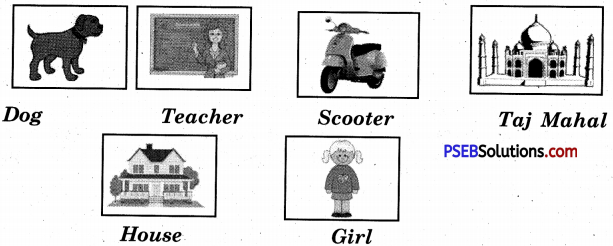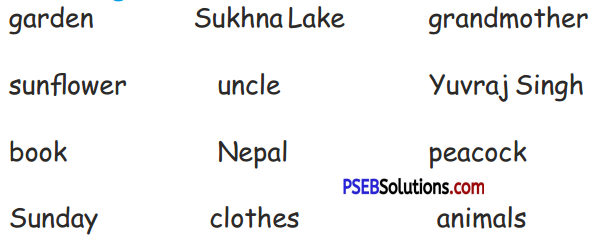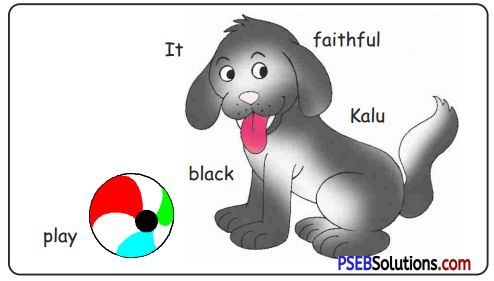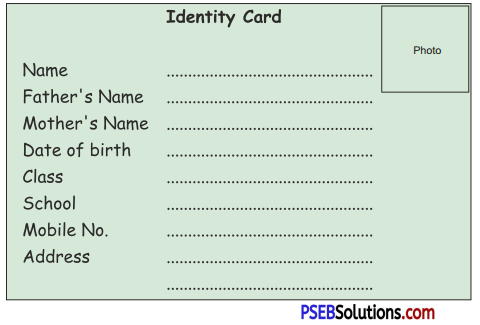Punjab State Board PSEB 5th Class Hindi Book Solutions Hindi Rachana Nibandh Lekhan निबंध-लेखन Exercise Questions and Answers, Notes.
PSEB 5th Class Hindi Rachana निबंध-लेखन
1. मेरा मित्र
राम मेरा पक्का मित्र है। वह पाँचवीं कक्षा में पढ़ता है। उसकी आयु 12 वर्ष है। वह बड़ा स्वस्थ और सुन्दर है। उसका कद लम्बा और बाल काले घने हैं। यह सदा साफ़-सुथरे वस्त्र पहनता है। वह बड़ा परिश्रमी है। उसके पिता जी एक वकील हैं। उसकी माता जी एक स्कूल में पढ़ाती हैं। राम बहुत होनहार लड़का है। वह परीक्षा में सदा प्रथम रहता है। वह कमज़ोर लड़कों की सहायता करता है। वह सदा समय पर स्कूल जाता है। वह सदा सच बोलता है। सभी अध्यापक उससे प्यार करते हैं। भगवान् करे, उसकी आयु लम्बी हो।
2. मेरा प्रिय अध्यापक
मेरे स्कूल में दस अध्यापक हैं। मैं श्री राम लाल को सबसे अधिक पसन्द करता हूँ। उनकी आयु 30 वर्ष की है। वे सुन्दर और स्वस्थ हैं। वे हमें हिन्दी पढ़ाते हैं। उनके पढ़ाने का ढंग बहुत अच्छा है। वे बड़े दयालु हैं। वे कमज़ोर लड़कों की हमेशा सहायता करते हैं। वे सदा साफ़ कपड़े पहनते हैं। वे एक अच्छे कवि हैं। वे सदा समय पर स्कूल आते हैं। वे अपने से बड़ों का सम्मान करते हैं। स्कूल के सभी बच्चे उन्हें बहुत प्यार करते हैं। हमें उन पर बड़ा गर्व है।
![]()
3. मेरी मुख्याध्यापिका
श्रीमती अजीत कौर मेरी मुख्याध्यापिका है। उनकी आयु 40 वर्ष की है। वे स्वस्थ और सुन्दर हैं। उनका कद लम्बा और बाल काले और लम्बे हैं। वे पाँचवीं श्रेणी को पढ़ाती हैं। वे बड़े सरल ढंग से पढाती हैं।। हमें उनकी हर एक बात समझ में आती है। वे | प्रातःकाल समय पर स्कूल में आती हैं और स्कूल | का चक्कर लगाती हैं। वे अध्यापिकाओं से बड़ा अच्छा व्यवहार करती हैं। वे बच्चों से बड़ा प्यार करती हैं। वे बच्चों के माता-पिता को भी समयसमय पर स्कूल बुलाती हैं। हमें उन पर बड़ा गर्व है।
4. मेरा स्कूल
अथवा
मेरा विद्यालय
मेरे स्कूल (विद्यालय) का नाम ‘सरकारी हाई स्कूल’ है। यह रेलवे स्टेशन के समीप ही स्थित है। इसमें दस कमरे हैं। हर कमरे में बिजली का पंखा लगा हुआ है। सभी कमरे बहुत अच्छे सजे हुए हैं। | मेरे स्कूल में छोटा-सा बाग है। इसमें सुन्दर फूल | खिले हुए हैं। स्कूल में एक खेल का मैदान भी है। हम आधी छुट्टी के समय यहाँ खेलते हैं। स्कूल में सभी अध्यापक अच्छे हैं। उनका पढ़ाने का ढंग बड़ा सरल है। इसलिए हमारे स्कूल के परिणाम सदा अच्छे रहते हैं। सच पूछो तो हमारा स्कूल हमारे नगर का सबसे अच्छा स्कूल है। मुझे अपने स्कूल पर गर्व है।
5. अच्छा विद्यार्थी
विद्या प्राप्त करने वाला विद्यार्थी कहलाता है। अच्छे विद्यार्थी को अपने गुरुओं का आदर करना चाहिए। उसको स्वस्थ होना चाहिए। उसे खूब ज्ञान प्राप्त करना चाहिए। उसे सादा जीवन बिताना चाहिए। उसे सदा अपने माता-पिता की आज्ञा माननी चाहिए। उसे सदा सच बोलना चाहिए। उसे सदा समय पर स्कूल जाना चाहिए। उसे मन लगाकर पढ़ना चाहिए। उसे खेलों में भी भाग लेना चाहिए। उसे सदा अच्छी बातें सोचनी चाहिएं। उसे बुरे लोगों से दूर रहना चाहिए।
6. गाय
गाय एक पालतू पशु है। उसकी चार टांगें, दो आँखें, दो कान और एक लम्बी पूँछ होती है। इसके दो सींग भी होते हैं। गाय हरी घास और भूसा खाती है। यह हमें दूध देती है। इसका दूध मीठा और स्वास्थ्य को बढ़ाने वाला होता है। इसके दूध से दही, लस्सी, मक्खन और घी बनता है। इसका दूध बच्चों, बूढ़ों और बीमार लोगों के लिए बहुत लाभदायक है। इसके गोबर से खाद तथा उपले बनते हैं। भारत के लोग गाय को गौ माता कहते हैं। हिन्दू इसकी पूजा करते हैं।
7. दशहरा
दशहरा भारत का प्रसिद्ध त्योहार है। यह दीवाली से 20 दिन पहले मनाया जाता है। 9 दिन तक रामलीला होती है और दसवें दिन दशहरे का त्योहार मनाया जाता है। इस दिन श्री रामचन्द्र जी ने रावण पर विजय पाई थी। इसलिए दशहरे को ‘विजयदशमी’ भी कहते हैं। दशहरे के दिन दुकानदार अपनी दुकानें सजाते हैं। इस दिन बाजारों में बड़ी भीड़ होती है। शाम के समय नगर के बाहर भारी मेला लगता है। सूर्य डूबने से कुछ समय पहले रावण, कुम्भकर्ण और मेघनाद के पुतलों को जलाया जाता है। लोग मेले की दुकानों से मिठाइयां तथा खिलौने खरीदते हैं और खुशी-खुशी घरों को लौट आते हैं।
8. दिवाली
दिवाली भारत का प्रसिद्ध त्योहार है। यह त्योहार दशहरे के बीस दिन बाद आता है। यह त्योहार श्री रामचन्द्र जी के अयोध्या लौटने की खुशी में मनाया जाता है। इसी दिन सिखों के छठे गुरु श्री गुरु हरिगोबिंद जी जहांगीर की नज़रबन्दी से आज़ाद होकर आए थे। पंजाब में अमृतसर की दिवाली देखने योग्य होती है। दिवाली के कुछ दिन पहले दुकानों तथा घरों में सफ़ेदी की जाती है। दिवाली के दिन दुकानदार दुकानें सजाते हैं। बाजारों में बड़ी में जाते हैं। वे मिठाइयां, पटाखे और खिलौने खरीदते हैं। रात के समय लक्ष्मी की पूजा की जाती है। सभी लोग अपने-अपने घरों में दीये जलाते हैं। बच्चे रात को पटाखे चलाते हैं।
9. मेरा प्रिय त्योहार
लोहड़ी पंजाब का एक प्रसिद्ध त्योहार है। यह जनवरी के महीने में आता है। त्योहार के दिन बच्चे प्रात:काल ही टोलियां बनाकर निकल पड़ते हैं। वे घर-घर जाकर लोहड़ी मांगते हैं और लोहडी के। गीत गाते हैं। लोग उन्हें रेवड़ियां, गुड़ तथा मक्की के भुने हुए दाने देते हैं। जिस घर में कोई विवाह हुआ हो या किसी बच्चे का जन्म हुआ हो, वहाँ से उन्हें और भी अधिक चीजें मिलती हैं। कुछ लोग उन्हें लकड़ियां और उपले भी देते हैं। रात के समय इनका एक ढेर लगाकर आग लगाई जाती है। लोग आग में चिड़वे और रेवड़ियों की. आहुति डालते हैं। काफ़ी 1 देर तक लोग आपस में बैठकर बातें करते हैं। इस प्रकार यह त्योहार खुशी के साथ-साथ भाईचारे का सन्देश भी देता है।
10. वैशाखी का त्योहार
वैशाखी पंजाब का एक प्रसिद्ध त्योहार है। पंजाब में यह त्योहार बड़ी धूमधाम से मनाया जाता है। यह कई कारणों से मनाया जाता है। इस समय तक किसानों की फसल पक जाती है और वे खुशी से
झूम उठते हैं। इसी दिन सन् 1699 ई० में गुरु गोबिन्द सिंह जी ने खालसा पंथ की नींव भी रखी थी। वैशाखी के दिन कई स्थानों पर मेले लगते हैं। इनमें खेलों के मुकाबले होते हैं।
11. व्यायाम
साधारण शब्दों में व्यायाम कसरत करने का नाम है। व्यायाम हमारे शरीर के लिए बहुत ज़रूरी है। शरीर में फुर्ती आती है। व्यायाम करने से हम स्वस्थ रहते हैं। व्यायाम करने वालों को बुढ़ापा जल्दी नहीं आता। शरीर सुन्दर और मजबूत बनता है। व्यायाम से खून का संचार बढ़ता है। स्त्रियों और पुरुषों के लिए अलग-अलग प्रकार के व्यायाम हैं। व्यायाम करने से काम में रुचि बढ़ती है और मन प्रसन्न रहता है। इसलिए शरीर को स्वस्थ रखने के लिए प्रतिदिन व्यायाम करना चाहिए क्योंकि अंग्रेजी की एक कहावत है कि स्वस्थ शरीर में ही स्वस्थ मन रहता है।
![]()
12. मेरा गाँव
भारत गाँवों का देश है। इसकी 80% जनता गाँवों में रहती है। मेरे गाँव का नाम ……… है। इसमें दो सौ के लगभग मकान हैं। अधिकतर मकान पक्के हैं, परन्तु कुछ मकान कच्चे भी हैं। गाँव की गलियां कच्ची हैं परन्तु गलियों में पक्की नालियां बनी हुई हैं। गाँव में एक छोटा-सा बाजार है। गाँव के बाहर एक डाकखाना है। इसमें एक डिस्पैंसरी भी है। यहाँ रोगियों को मुफ्त दवा दी जाती है। गाँव में एक पंचायत घर भी है। इसके चारों ओर हरे-भरे खेत हैं। मेरे गाँव के निवासी बहुत अच्छे हैं। वे कभी एक दूसरे से नहीं लड़ते। मुझे अपने गाँव पर गर्व है। मेरा गाँव एक आदर्श गाँव है।
13. मेरा देश
भारत मेरा प्यारा देश,
सब देशों से न्यारा देश।
मेरे देश का नाम भारत है। यह एक विशाल देश है। इसकी आबादी 125 करोड़ के लगभग है। यह 28 राज्यों पर आधारित है। यह तीनों ओर से समुद्र से घिरा हुआ है। इसके उत्तर में हिमालय पर्वत है। मेरे देश की धरती बड़ी उपजाऊ है। इस देश में गंगा-यमुना जैसी महान् नदियां बहती हैं। यहाँ की धरती में खनिज पदार्थों के भण्डार भी छिपे पड़े हैं। इस देश में लगभग सभी धर्मों के लोग रहते हैं। अब भारत प्रगति के मार्ग पर अग्रसर है। यहाँ अनेक उद्योग-धन्धे पनप रहे हैं। मुझे अपने देश पर गर्व है क्योंकि “सारे जहाँ से अच्छा हिन्दोस्तां हमारा।”
14. स्वतन्त्रता दिवस
हमारा देश 15 अगस्त, 1947 को स्वतन्त्र हुआ था। इसलिए हम हर साल 15 अगस्त को स्वतन्त्रता दिवस मनाते हैं। यह दिन भारत में बड़ी धूम-धाम से मनाया जाता है। इस दिन लाल किले पर तिरंगा झण्डा फहराया जाता है। इसके बाद प्रधानमन्त्री भाषण देते हैं। इस दिन स्थान-स्थान पर खेल, नाटक, कवि दरबार, नाच-गाने आदि होते हैं। रात को दीपमाला होती है। यह दिन हमें याद दिलाता है कि हमें | आज़ादी की हर तरह से रक्षा करनी चाहिए।
15. छब्बीस जनवरी
26 जनवरी हमारा गणतन्त्र दिवस है। हम हर वर्ष इसे बड़ी धूमधाम से मनाते हैं। गणतन्त्र दिवस का मुख्य समारोह दिल्ली में होता है। इस वर्ष 26 जनवरी को हमारे स्कूल में गणतन्त्र दिवस मनाया गया। स्कूल को अच्छी तरह सजाया गया। समारोह में मुख्य अतिथि के लिए एस० डी० एम० को बुलावा दिया गया। वे प्रातः नौ बजे स्कूल पहुंचे। द्वार पर अध्यापकगण ने उनका स्वागत किया। स्कूल के बैंड ने स्वागती धुन बजाई। वे मंच पर पहुँचे और उन्होंने राष्ट्रीय झण्डे को फहराया। सभी ने मिलकर राष्ट्रीय गान गाया। तब समारोह आरम्भ हुआ। कई प्रकार के खेल और नाटक प्रस्तुत किए गए। कुछ विद्यार्थियों ने देश प्यार के गीत और कविताएं गाईं। विजेताओं को इनाम दिए गए। बारह बजे समारोह समाप्त हो गया। हम सभी खुशी-खुशी घर लौट आए।
16. श्री गुरु नानक देव जी
श्री गुरु नानक देव जी सिक्खों के पहले गुरु थे। उनका जन्म तलवण्डी गाँव में हुआ। इस स्थान को आजकल ननकाना साहिब कहते हैं। अब यह पाकिस्तान में है। उनके पिता जी का नाम मेहता कालू राम जी और माता जी का नाम तृप्ता जी था। बचपन से उनका ध्यान ईश्वर की भक्ति करने की ओर था। उन्होंने अपना सारा जीवन लोगों की भलाई में लगा दिया। उन्होंने स्थान-स्थान पर घूम कर लोगों को अपना उपदेश दिया। उन्होंने लोगों को बताया कि ईश्वर एक है और हम सब भाई-भाई हैं। उन्होंने लोगों को नेक कमाई करने और सत्यनाम का जाप करने की शिक्षा दी।
17. अमृतसर की सैर
अमृतसर एक सुन्दर नगर है। यह हमारा पवित्र तीर्थ स्थान है। इसे गुरु की नगरी भी कहते हैं। गत रविवार मैं अपने पिता जी के साथ अमृतसर गया। सबसे पहले हम दरबार साहिब देखने गए। हमने बाबा अटल का ऊँचा बुर्ज तथा कई अन्य भवन देखे। इसके बाद हमने जलियांवाला बाग देखा। यहां सन् 1919 ई० में अनेक लोग शहीदी को प्राप्त हुए थे। वहां से हम दुर्गियाना मन्दिर देखने गए। यह मन्दिर दुर्गा देवी के नाम पर बना है। हमने कम्पनी बाग भी देखा। अमृतसर नगर शिक्षा तथा व्यापार का केन्द्र है। हमने अनेक बाज़ार तथा गलियां देखीं। शाम को हम माल रोड की सैर को निकले। सच तो यह है कि अमृतसर की सैर से मन मुग्ध हो गया।
18. श्री गुरु गोबिन्द सिंह जी
श्री गरु गोबिन्द सिंह जी सिक्खों के दसवें गुरु थे। उनका जन्म पटना में सन् 1666 ई० में हुआ। उनको अच्छी शिक्षा दी गई। उन्हें घुड़सवारी, तीर तथा तलवार चलाना भी सिखाया गया। उनकी आयु अभी 9 वर्ष की थी कि उनके पिता जी को शहीद कर दिया गया। पिता जी की शहीदी के बाद वह सिक्खों के गुरु बने। उन्होंने सन् 1699 ई० में खालसा पंथ की स्थापना की और सिक्खों को नाम के आगे ‘सिंह’ शब्द लगाने का आदेश दिया। गुरु जी ने देश की जनता की रक्षा की। वह ग़रीबों का सहारा बने। उन्होंने ऊँच-नीच का भेदभाव मिटाया। उन्होंने धर्म की रक्षा के लिए अपने चारों पुत्रों का बलिदान दे दिया। वे जीवन भर लड़ते रहे। उन्होंने अन्याय के सामने कभी शीश नहीं झुकाया। इतिहास में उनका नाम सदा अमर रहेगा।
![]()
19. समाचार-पत्र
समाचार-पत्र के द्वारा हम घर पर बैठे ही देशविदेश के समाचारों को जान लेते हैं। संसार के किसी कोने में घटने वाली घटना तार, टेलीफोन अथवा टेलीप्रिंटर के द्वारा समाचार-पत्रों के कार्यालयों में पहुँच जाती है।
समाचार-पत्रों से हमें अनेक लाभ हैं। नगर, प्रान्त, देश तथा विदेश आदि के समाचारों को हम समाचारपत्र द्वारा घर बैठे जान लेते हैं। इससे हमारे ज्ञान में भी वृद्धि होती है। समय-समय पर इनमें अनेक प्रकार के चित्र भी छपते रहते हैं। इन चित्रों के द्वारा जहाँ हमारा मनोरंजन होता है, वहाँ इनसे अनेक प्रकार के ऐतिहासिक, धार्मिक, प्राकृतिक स्थानों की भी जानकारी होती है।
समाचार-पत्रों में कहानियां, कविताएँ, जीवनियां तथा हास्य की सामग्री भी छपती रहती है। इन्हें पढ़कर हमारा मनोरंजन होता है। समाचार-पत्र सब के लिए उपयोगी हैं।
20. हॉकी का मैच
रविवार का दिन था। मैं अपने भाई के स्कूल में गया। वहाँ हॉकी का मैच हो रहा था। एक ओर जैन स्कूल की तथा दूसरी ओर हीरो स्कूल की टीम थी। जैन स्कूल के खिलाड़ी बड़ा अच्छा खेल रहे थे। उनका कप्तान बाल लेकर दौड़ा और उसने गोल कर दिया। शीघ्र ही मध्यान्तर (आधा समय) हो गया।
मध्यान्तर के बाद मैच फिर शुरू हुआ। हीरो स्कूल के लड़के जोश में आ गए। वे एक होकर खेलने लगे। शीघ्र ही उन्होंने गोल कर दिया। मुकाबला अन्त तक होता रहा। कोई भी टीम और गोल न कर सकी। अन्त में मैच बराबर रहा।
21. मेरा प्रिय नेता
अथवा
महात्मा गांधी
महात्मा गांधी भारत के महान् नेताओं में से थे। उन्होंने अहिंसा और सत्याग्रह के प्रयोग से अंग्रेज़ों को भारत छोड़ने पर विवश कर दिया। दुनिया के इतिहास में उनका नाम हमेशा अमर रहेगा। गाँधी जी मेरे प्रिय नेता थे।
इस महापुरुष का जन्म 2 अक्तूबर सन् 1869 को गुजरात काठियावाड़ के पोरबन्दर स्थान पर हुआ। आप मोहनदास कर्मचन्द गाँधी के नाम से प्रख्यात हुए। आपके पिता राजकोट राज्य में दीवान थे। माता पुतलीबाई बहत धार्मिक प्रवृत्ति की महिला थी। गाँधी जी को उच्च आदर्शों और संस्कारों की शिक्षा इनकी माता जी से ही मिली।
महात्मा गांधी ने उच्च शिक्षा प्राप्त कर भारत की आज़ादी के लिए संघर्ष शुरू कर दिया। उन्होंने अहिंसा के शस्त्र से भारत में अंग्रेज़ शासन का अन्त कर दिया। जिसके परिणामस्वरूप 15 अगस्त, सन् 1947 को भारत आज़ाद हुआ।
स्वतन्त्रता का पुजारी बापू गाँधी 30 जनवरी, सन् 1948 को एक मनचले नौजवान नाथूराम गोडसे की गोली का शिकार हुआ। अहिंसा का सबसे बड़ा उपासक हिंसा की भेंट चढ़ गया। देशवासी गांधी जी को सदा स्मरण रखेंगे।
22. प्रातःकाल की सैर
प्रात:काल का समय बड़ा सुहावना होता है। इस समय ताज़गी छाई हुई होती है। प्रात:काल का वातावरण मन को अतीव प्रसन्नता देने वाला तथा स्फूर्तिदायक होता है। प्रकृति इस समय अपना अनुपम सौन्दर्य प्रदर्शित करती है। सुबह सवेरे नर्म-नर्म बिस्तर को छोड़कर जो व्यक्ति भ्रमण का आनन्द लूटता है, प्रकृति उसे धनवान, बुद्धिमान् और स्वस्थ होने का वरदान देती है।
गर्मियों में साढ़े चार या पाँच तथा सर्दियों में साढ़े पाँच-छ: बजे का समय भ्रमण के लिए उपयुक्त समय है। बिस्तर छोड़ने में थोड़ा-सा कष्ट अवश्य अनुभव होता है लेकिन जब हम उठ बैठते हैं तो सारा आलस्य भी समाप्त हो जाता है। प्रात:काल की सैर स्वास्थ्य के लिए बहुत ही श्रेष्ठ है। इससे व्यक्ति नीरोग रहता है। चेहरा खिला रहता है। पढ़ने में दिल लगता है। प्रात: की सैर सबके लिए अच्छा व्यायाम है।
23. बसन्त ऋतु बसन्त ऋतु का आगमन चैत्र तथा वैशाख के महीनों में होता है। इन्हीं महीनों में न ठिठुराने वाला जाड़ा होता है, न भयंकर झुलसाने वाली लू चलती हैं, न वर्षा होती है। खुले दिन होते हैं। सभी बेलों तथा वृक्षों पर फूल-पत्ते आ जाते हैं। बागों में नई बहार आ जाती है। आम, अनार, अमरूद आदि वृक्षों पर बौर आ जाता है। कोयल पंचम स्वर में गाने लगती है।
खेतों में वसन्ती रंग के सरसों के फूल तथा नीले रंग के अलसी के फूल सबके मन को मोह लेते हैं। अत: लोग बसन्त की बहार को देखने के लिए घरों से निकल पड़ते हैं तथा इसका सुहावना आनन्द लेते हैं। शीत ऋतु का जमा हुआ रक्त पिघल कर शरीर के प्रत्येक अंग में पहुँचता है।
इस ऋतु का बड़ा महत्त्व यह भी है कि इस ऋत के आरम्भ में अपने धर्म पर बलिदान होने वाले हकीकत राय को धर्मान्ध काज़ियों ने मरवा दिया था। वीर हकीकत की याद में यह त्योहार धूमधाम से मनाया जाता है। वसन्त ऋतु मुझे बहुत प्रिय लगती है।
![]()
24. रंगों का पर्व : होली
भारत त्योहारों का देश है। इस देश में प्रायः प्रत्येक महीने में कोई न कोई त्योहार अवश्य आता है। रंगों का त्योहार होली का आगमन मार्च के महीने में होता है। इस पर्व में चारों ओर रंगों की बहार आ जाती है। कहीं अबीर उड़े तो कहीं गुलाल चले, कहीं पिचकारी है तो कहीं रंगों में रंगे लोग मस्ती में गा रहे हैं। चारों ओर प्रसन्नता और उल्लासता छा जाती है।
होली का आरम्भ कब हुआ इसके सम्बन्ध में कथा प्रचलित है कि नास्तिक हिरण्यकश्यपु राजा ने अपने पुत्र प्रह्लाद को जला देने की सोची। हिरण्यकश्यपु की बहन होलिका जिसे यह वरदान मिला था कि आग में जल नहीं सकती, प्रह्लाद को गोद में लेकर आग में जा बैठी। प्रह्लाद तो बच गया पर होलिका जल गई। तभी से यह उत्सव मनाया जाता है। इस दिन लोग सुबह से ही मित्रों की टोलियां बनाकर अपने मित्रों को रंगने के लिए घरों से निकल पड़ते हैं। चारों ओर होली है-होली है का शोर सुनाई देता है। ब्रज और मथुरा की होली का तो रूप ही और होता है। रंगों से रंगे हुए, गाते बजाते, नाचते हुए मस्ती से भरे लोग सब तरफ दिखाई पड़ते हैं। यह त्योहार परस्पर द्वेष, वैर भाव भुलाकर प्रेमपूर्वक मिलकर रहने का सन्देश देता है।
25. मेरा घर
मेरा घर शहर के एक साफ़-सुथरे इलाके में स्थित है। यह शहर के बीचों-बीच स्थित है। मेरे घर में मेरे साथ-साथ मेरी माता जी, पिता जी तथा मेरा छोटा भाई भी रहते हैं। मेरे घर में छ: कमरे हैं। सभी सदस्यों के लिए अलग-अलग कमरे हैं। मेरा भी अपना एक अलग कमरा है। मेरा घर दो मंजिला है। मेरा कमरा दूसरी मंजिल पर है। यहाँ पर मेरी सभी वस्तुएँ रखी हुई हैं। मेरा एक अलग से पढ़ने का कमरा भी है। यहाँ पर बैठ कर मैं अपनी पढ़ाईलिखाई करता हूँ। सभी कमरे खुले और हवादार हैं। सभी कमरों पर संगमरमर का फर्श है। कमरों की दीवारों पर रंग किया हुआ है। सभी कमरे सुन्दर ढंग से सजे हुए हैं। मेरे घर में एक सुन्दर बागीचा भी है। यहां पर रंग-बिरंगे तथा सुन्दर-सुन्दर फूल लगे हुए हैं। फूलों की सुगन्ध मन को मोह लेती है। शाम के समय हम बागीचे में बैठते तथा खेलते हैं। पक्की ईंटों और संगमरमर से बना मेरा घर सचमुच बहुत सुन्दर है। मुझे अपने घर पर गर्व है।
26. किसान
भारत देश एक कृषि प्रधान देश है। यहाँ के अधिकतर लोग खेती-बाड़ी का कार्य करते हैं। किसान सारे लोगों के लिए भोजन देने का कार्य करते हैं, इसीलिए इन्हें ‘अन्नदाता’ कहा जाता है। किसान दिन-रात अपने खेतों में मेहनत करके अन्न उत्पन्न करता है। गर्मी, सर्दी, वर्षा, आँधी-तूफ़ान चाहे कैसी भी ऋतु हो वह तो अपने खेतों में डटा रहता है। उसके लिए कोई रविवार नहीं, कोई छुट्टी नहीं, उसका तो बस काम ही पूजा है। अपनी मेहनत से बोई हुई फसलों को पकते हुए देखकर वह फूला नहीं समाता। पकी हुई फसलों को देखकर वह खुशी से झूम उठता है।
देश में क्या हो रहा है, इन सब बातों से उसे जैसे कोई सरोकार नहीं उसे यदि ध्यान रहता है तो अपने खेतों का, चिन्ता यदि कोई है तो बस यही कि कहीं फसल खराब न हो जाए। किसान बहुत ही सरल हृदय तथा निष्कपट स्वभाव के होते हैं। उसके लिए तो बस काम व परिश्रम ही ईश्वर की सच्ची पूजा है। पहले किसान खेतों में हल चलाने के लिए बैलों का सहारा लेते थे पर आजकल ट्रेक्टरों आदि का सहारा लिया जाता है। गेहूँ, धान आदि फसलों को बोना, उगाना, संभालना और समय पर मण्डी पहुँचाना तथा फिर नई फसलों को बोना ही उसका जीवन-चक्र है।
27. हमारा देश
हमारे देश का नाम भारत है। यह हमारी मातृभूमि है। दुष्यन्त और शकुन्तला के पुत्र भरत के नाम पर इसका भारत नाम पड़ा। यह एक विशाल देश है। जनसंख्या की दृष्टि से यह संसार में दूसरे स्थान पर है। इसकी जनसंख्या 125 करोड़ से अधिक है। यहाँ पर अलग-अलग जातियों के लोग रहते हैं।
भारत के उत्तर में हिमालय है और शेष तीनों ओर समुद्र है। स्थान-स्थान पर हरे-भरे वन इसकी शोभा हैं। यह एक कृषि प्रधान देश है। यहाँ की 80% जनता गाँवों में रहती है। यहाँ गेहूँ, मक्का -बाजरा, ज्वार, चना, धान, गन्ना आदि फसलें होती हैं। यहाँ की धरती बहुत उपजाऊ है। यहाँ गंगा-यमुना जैसी पवित्र नदियाँ बहती हैं। इसकी भूमि से लोहा, कोयला, सोना आदि कई प्रकार के खनिज पदार्थ निकलते हैं।
यहाँ पर कई धर्मों के लोग निवास करते हैं। सभी प्रेम से रहते हैं। यहाँ पर अनेक तीर्थस्थल हैं। ताजमहल, लालकिला, सारनाथ, शिमला, मंसूरी, श्रीनगर आदि पर्यटन स्थल हैं जो देखने योग्य हैं। यहाँ पर कई महापुरुषों ने जन्म लिया। राम-कृष्ण, गुरुनानक, दयानन्द, रामतीर्थ तिलक, गांधी आदि इस देश की शोभा थे। यहाँ के राष्ट्रपति श्री प्रणब मुखर्जी हैं। यह देश दिन दुगुनी रात चौगुनी उन्नति कर रहा है।
28. खेलों के लाभ
विद्यार्थी जीवन में खेलों का बड़ा महत्त्व है। पुस्तकों में उलझ कर थका-मांदा विद्यार्थी जब खेल 1 के मैदान में जाता है तो उसकी थकावट तुरन्त गायब हो जाती है। विद्यार्थी अपने आप में चुस्ती और
ताज़गी अनुभव करता है। मानव जीवन में सफलता के लिए मानसिक, शारीरिक और आत्मिक शक्तियों के विकास से जीवन सम्पूर्ण बनता है।
स्वस्थ, प्रसन्न, चुस्त और फुर्तीला रहने के लिए शारीरिक शक्ति का विकास ज़रूरी है। शरीर का विकास खेल-कूद पर निर्भर करता है। यदि हम सारा दिन कार्य करते हैं तो शरीर में घबराहट, चिड़चिड़ापन या सुस्ती छा जाती है। ज़रा खेल के मैदान में जाइये, फिर देखिए घबराहट, चिड़चिड़ापन या सुस्ती केसे दूर भागती है। शरीर हल्का-फुल्का और साहसी बन जाता है। मन में और अधिक कार्य करने की लगन पैदा होती है।
खेलों में भाग लेने से विद्यार्थी खेल के मैदान में से अनेक शिक्षाएं ग्रहण करता है। खेलें संघर्ष द्वारा विजय प्राप्त करने की भावना पैदा करती हैं। खेलें हँसते-हँसते अनेक कठिनाइयों पर विजय प्राप्त करना सिखा देती हैं। खेल के मैदान में विद्यार्थी के अन्दर अनुशासन में रहने की भावना पैदा होती है। सहयोग करने तथा भ्रातृभाव की आदत बनती है।
29. मेरा मनपसंद खेल
आज हमारे भारत देश में अनेक खेल खेले जाते हैं। उन सब खेलों में कबड्डी का खेल मेरा प्रिय खेल है। यह खेल सब खेलों में सस्ता खेल है। आज यह खेल भी राष्ट्रीय खेल में गिना जाता है। यह दो प्रकार का है-पंजाबी कबड्डी और नेशनल कबड्डी।
यह खेल भी दो पक्षों में खेला जाता है। इस खेल की प्रत्येक टीम में सात खिलाड़ी होते हैं। यह खेल केन्द्र में रेखा डालकर खेला जाता है। यह खेल किसी मैदान में खेला जाता है। इस खेल में से एक खिलाड़ी का सांस यदि टूट जाता है और विपक्ष के खिलाड़ी उसे छू लेते हैं या पकड़ लेते हैं तो रैफरी उसे मरा हुआ घोषित कर देता है। इस प्रकार विपक्ष एक अंक प्राप्त कर लेता है।
यदि वह खिलाड़ी दूसरे पक्ष के जितने खिलाड़ियों को छूकर अपने पक्ष में लौट आता है तो रैफरी विपक्ष के उतने ही खिलाड़ियों को मरा हुआ घोषित कर देता है। इस प्रकार यह बीस मिनट तक चलता है। बीस मिनट बाद रैफरी अर्धावकाश की सीटी मार देता है। अर्धावकाश पांच मिनट का होता है। इस समय में खिलाड़ी जलपान करते हैं। इसके अतिरिक्त दोनों टीमों के प्रशिक्षक अपने खिलाड़ियों की गलतियों को बताते हैं।
पाँच मिनट बाद रैफरी की सीटी के बाद फिर खेल उसी क्रम से शुरू होता है और बीस मिनट के बाद फिर समाप्त हो जाता है। पहले तथा दूसरे समय में जो टीम ज्यादा नम्बर लेती है वही विजयी होती है।
![]()
30. ग्रीष्म ऋतु
बसन्त की समाप्ति पर ग्रीष्म का आगमन होता है। ग्रीष्म ऋतु ज्येष्ठ और आषाढ़ महीनों में पड़ती है। बसन्त में चलने वाली मन्द-मन्द हवा ग्रीष्म के आते ही गर्म हवा में बदल जाती है जिसे दूसरे शब्दों में ‘लू’ कहते हैं।
ग्रीष्म के प्रारम्भ होते ही दिन भी मानों गर्मी से फैलने लगते हैं। सूर्य का उदय शीघ्र ही हो जाता है और फिर अस्ताचल की ओर उसका गमन भी देर से होता है। दोपहर के समय तो मानो आकाश से अंगारे बरसते हैं। एक ओर जलाती हुई लू तो दूसरी ओर जलाती हुई भूमि। इस समय बाहर निकलना भी एक समस्या बन जाता है। पशु-पक्षी भी इस समय पेड़ों के नीचे विश्राम करते हैं।
